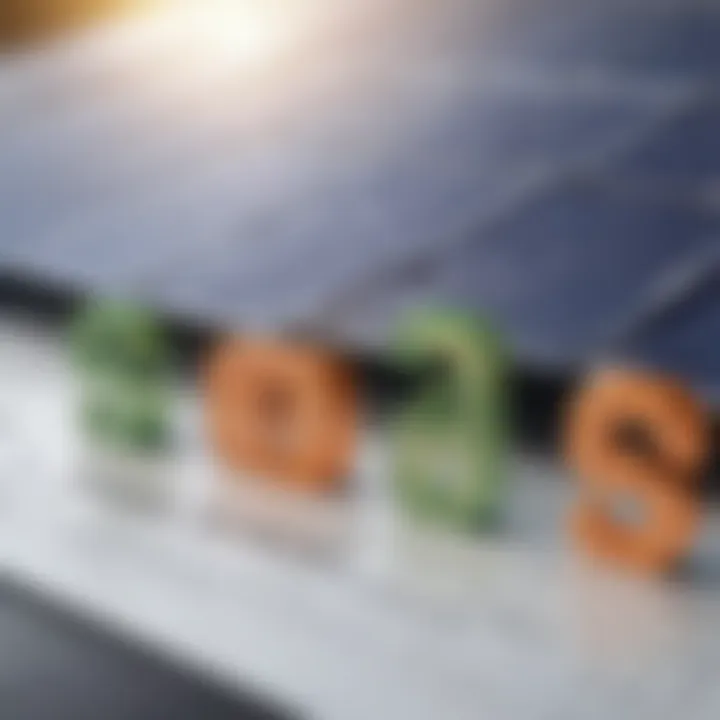Evaluating the Financial Impact of Solar Arrays


Intro
As the world increasingly shifts towards sustainable energy sources, solar power has emerged as a frontrunner in the quest for green alternatives. The decision to invest in solar arrays is not merely about harnessing energy from the sun; it's a multifaceted choice that involves understanding the financial dynamics at play. This article aims to provide an exhaustive analysis of the costs associated with acquiring and installing solar arrays, from an investor's standpoint.
In the following sections, we will break down key aspects related to the costs of solar investments. By delving into investment definitions, expert advice, financial incentives, and long-term benefits, we aim to arm investors, entrepreneurs, and financial analysts with the knowledge they need to navigate the complexities of solar energy investments. As these systems become more prevalent, having a solid grasp on the economic implications is paramount to making sound financial choices.
Let’s dig deeper into the Investment Definitions, where we will clarify essential terms and investment strategies that will set the stage for understanding the solar market.
Understanding Solar Arrays
Solar arrays represent a cornerstone in the realm of renewable energy. Understanding how these systems function and the variety of types available is essential for anyone considering investing in solar technology. By grasping the basic principles behind solar arrays, investors and consumers alike can make enlightened choices that align with their financial goals and environmental responsibilities.
The significance of understanding solar arrays stems from their role in generating clean energy while potentially saving users substantial amounts on their electricity bills. Moreover, comprehending their components and functionality can lead to better long-term decisions, enhancing the economic advantages associated with solar investments. In this section, we will delve into the definition and various types of solar arrays, outlining their benefits and implications within the broader context of energy choices.
Definition and Functionality
Solar arrays, in essence, are assemblies of solar panels designed to capture sunlight and transform it into usable energy. The functionality of these arrays hinges on the principles of photovoltaics and thermal energy conversion. Upon sunlight striking the solar cells, an electrical current is generated, which can either power appliances directly or be fed into the grid.
The core functionality revolves around their ability to harness renewable resources, which is paramount in the move towards sustainability. Unlike traditional fossil fuels, solar arrays offer a cleaner alternative, helping to reduce greenhouse gas emissions and combat climate change.
Types of Solar Arrays
When it comes to solar arrays, several types stand out, each with its unique structure and efficacy. Understanding these varieties helps lay a foundation for discerning which technology best meets specific energy needs and budgetary constraints.
Photovoltaic Cells
Photovoltaic cells are perhaps the most well-known form of solar arrays. These cells convert sunlight directly into electricity using semiconductor materials, primarily silicon. One notable characteristic of photovoltaic cells is their modular nature, allowing them to be scaled up based on energy requirements. This scalability makes them a popular choice among residential and commercial users.
A unique feature of photovoltaic cells is their ability to perform even in low light conditions, albeit at a reduced efficiency. This adaptability can be a key advantage in less sunny areas, making them a dependable option across various climates.
Concentrated Solar Power
Concentrated solar power (CSP) is another prominent category in solar technology. CSP systems utilize mirrors or lenses to focus a large area of sunlight onto a small area, generating heat that can then produce steam to drive a turbine. The standout characteristic of CSP technology is its efficiency for large-scale energy production, particularly in sunny, arid regions.
One unique advantage is the ability to store thermal energy, which allows CSP plants to continue generating power even when the sun goes down. However, the initial investment and land requirements can be considerable drawbacks, making it less appealing for smaller scale or residential projects.
Thin-Film Technology
Thin-film technology presents a lightweight and potentially more cost-effective option for solar energy. Unlike traditional silicon panels, thin-film solar cells are made by depositing a thin layer of photovoltaic material onto a substrate, which can be a flexible surface. This flexibility is a key characteristic, allowing for integration into various applications, from building-integrated photovoltaics to portable solar solutions.
A distinct feature of thin-film technology is its lower production costs and reduced material use compared to conventional solar panels. However, the downside often comes in the form of lower efficiency and larger areas required to produce equivalent power output, making them less efficient in space-constrained installations.
In summary, understanding the different types of solar arrays is critical when evaluating solar investment options, as each type offers distinct advantages and challenges that can cater to various needs and expectations.
Factors Influencing Solar Array Costs
Understanding the costs associated with solar arrays is vital for anyone considering a shift to solar energy. Each element contributes to the overall expenditure, making it crucial to dissect and comprehend what influences these prices. From the materials used and labor costs to geographical factors, pinpointing each aspect can enable potential investors to forecast their financial commitment more accurately.
Component Costs
Solar Panels
The core of any solar array is the solar panels themselves. Their quality and efficiency significantly affect the overall cost. Modern solar panels come with a range of specifications, touching on efficiency, wattage, and durability. With efficiencies often between 15% and 22%, choosing a panel that balances output and expense is essential. Investing in higher efficiency panels, though initially pricier, can yield better long-term savings by producing more energy over their lifespan. The technology behind them also varies; for instance, monocrystalline panels tend to offer better performance in limited space, though at a premium price. On the flip side, polycrystalline options are generally cheaper but with slightly lower efficiency.
Inverters
Inverters are another crucial component that puts a dent in the budget. They convert direct current (DC) generated by the panels into alternating current (AC) used by home appliances. The choice between string inverters or microinverters can affect both performance and price. Microinverters allow for individual panel optimization, meaning they can outperform string inverters in shaded conditions, potentially saving on later costs where performance could drop. Remember, though, that higher costs can accompany better technology. Balancing initial investment against long-term performance is essential when evaluating options.
Mounting Equipment


A seemingly minor expense that can snowball is the mounting equipment. Its purpose is to securely attach the solar panels to your roof or the ground, and it's crucial for maximizing array efficiency. The mounting structure must suit your specific installation type, whether it's roof-mounted or ground-mounted. The uniqueness of each installation site often demands different mounting systems, ranging from fixed frames to adjustable options that can adapt to changing sun positions. While cheaper systems are available, they may not hold up to harsh weather conditions, leading to more costs down the road for repairs or replacements.
Installation Expenses
Labor Charges
Labor charges constitute a significant portion of solar installation costs. The expertise of the professionals doing the installation can greatly influence the overall expense. Professional installation ensures systems run efficiently and comply with local regulations, but costs can fluctuate based on labor market conditions. Investing in qualified installers can lead to better longevity and efficiency of your solar array, potentially saving on costly repairs down the line.
Permitting Fees
Obtaining necessary permits introduces another layer of cost and complexity. Local regulations vary widely; some jurisdictions might have stringent permit requirements, while others might be more lenient. Despite seeming like an unnecessary expense, securing the right permits is crucial for legal compliance. Inadequate paperwork can result in significant fines or even forced removal of the array. Taking the time to research your area’s requirements can help clarify what to expect financially.
System Design
The design of your solar array shapes its efficiency and effectiveness which directly ties into costs. Custom designs tailored to your specific energy needs can initially seem pricey, yet they ensure that the system is optimized for your space and energy consumption. A poorly designed system may lead to wasted potential and higher costs over time as adjustments might become necessary. While cookie-cutter solutions may appeal due to lower upfront costs, they could ultimately come back to bite you down the line.
Geographical Variations
Local Climate Considerations
Local climate plays an underappreciated role in determining the suitability and efficiency of solar arrays. Regions with higher sunlight exposure typically see quicker returns on investment for solar systems compared to those in cloudier areas. For example, a homeowner in sunny Arizona may generate more value from their panels than one in Seattle. Understanding these local climatic nuances helps in evaluating the potential energy generation of your future system.
Incentive Availability
Incentive availability can vary drastically, with some areas offering substantial financial benefits for solar installations. Local, state, and federal programs might provide tax rebates, grants, or credits that offset the initial investment. Researching available incentives is imperative. In some cases, the right incentives can make a seemingly expensive installation much more feasible, often changing the entire cost landscape.
Estimating the Total Cost of a Solar Array
Understanding how to estimate the total cost of a solar array is crucial for anyone considering this green investment. Getting a clear picture of the expenses involved not only helps in budgeting but also informs potential savings and return on investment. This section shines a spotlight on various cost components, leading to a more comprehensive grasp of what to expect financially when embarking on a solar project. It's like laying down all your cards on the table before the big game; you wouldn't want to take the plunge without knowing the stakes.
Typical Price Ranges
When talking about the cost of solar arrays, it can often feel like running through a minefield where you need to tread carefully. The price range for installing a solar array can vary significantly based on multiple factors—type of technology, system size, and even geographic location all play a big role. To give you a snapshot:
- Residential Systems: These typically range from $10,000 to $30,000 after federal incentives.
- Commercial Systems: For larger setups, you might be looking at $50,000 to $200,000 or more, depending on the scale.
- Utility-Scale Systems: Here, costs can soar into the millions, anywhere from $1 million to $10 million depending on capacity.
While this may sound daunting, it's essential to remember these are just ballpark figures. Different installations will have their own unique circumstances. As you weigh your options, understand that higher initial costs can sometimes translate to more significant long-term savings.
Cost per Watt Calculation
To demystify solar costs further, let’s break down the concept of cost per watt. This measurement is like the bread and butter of solar economics. It evaluates how much you’re spending for each watt of solar energy produced by your array. Understanding this ratio can give you clear visibility on whether you’re getting a fair shake.
Typical costs per watt for residential solar systems can average around $2.50 to $3.50 but can dip lower or climb higher based on the factors mentioned earlier.
The cost per watt serves as a handy benchmark. If you're being quoted much higher than the average range, it’s time to ask why.
To put this into perspective, if you install a 5 kW system and the cost per watt is $3.00, the total expense would be:**
Financial Incentives for Solar Energy
Understanding the costs associated with solar arrays often leads to one overarching question: how can financial incentives ease this journey? Financial incentives play a crucial role in prompting individuals and businesses to invest in solar energy. They can significantly decrease upfront expenses and enhance the overall appeal of solar systems. Not only do these incentives help mitigate initial costs, but they also contribute to a broader goal of promoting sustainable energy and reducing reliance on fossil fuels.
Government Tax Credits
Government tax credits serve as a significant financial incentive for solar energy investment. One notable example is the Investment Tax Credit (ITC), which allows individuals and businesses to deduct a percentage of their solar system's cost from their federal taxes. As of recent years, this percentage stands at a hefty 26%, a number that can bring substantial relief to the wallet, particularly for larger installations. It’s not just about slashing taxes; it’s an endorsement of clean energy that nudges states and local governments to offer complimentary incentives, amplifying the benefits.
However, the ITC is not immutable. It operates under a phasedown schedule, meaning that the percentage available to new projects will decrease incrementally in the upcoming years. Potential investors should keep this in mind, as the earlier they act, the more significant the tax breaks can prove to be.
Rebates and Grants


In addition to tax credits, rebates and grants provide additional financial breathing room. Many states and local governments offer rebates for solar installations, which can effectively lower the cost of the system after installation. For instance, certain states provide upfront rebates that can be applied immediately during the purchase process, making solar arrays more financially viable.
Grants, more selective in nature, can also help defray costs. Institutions such as nonprofit organizations and educational facilities may qualify for specific grants aimed at promoting solar energy usage or sustainable practices. These opportunities can reduce out-of-pocket expenses, making solar energy even more enticing. Participating in local renewable energy programs may also open the doors to various funding options, so it pays to do some homework.
Net Metering Benefits
Net metering is another pivotal financial incentive that significantly enhances the economics of solar energy. This mechanism allows homeowners and business owners to earn credits for the surplus energy their solar arrays produce. When solar panels generate more electricity than what the property consumes, that excess power can be fed back into the grid, essentially spinning the meter backward.
Depending on state regulations, these credits can substantially reduce electricity bills, and in some fortunate instances, even lead to monthly net zero utilities. It’s crucial to realize that net metering policies can vary dramatically, so it’s wise to understand local regulations and structures when considering solar investment.
In many cases, coupling tax credits, rebates, and net metering can lead to significant cost savings, making solar energy a sensible financial decision.
In summary, leveraging financial incentives is vital for anyone contemplating a solar array investment. Government tax credits, rebates and grants, along with net metering benefits, collectively help soothe the financial burden of installation, making solar not just an environmentally friendly choice but a financially savvy one as well.
Long-Term Financial Considerations
When evaluating solar energy systems, it’s easy to get caught in the initial costs. At first glance, those upfront expenses can seem daunting. However, looking at the long-term financial implications offers a more favorable outlook. Long-term financial considerations encompass not just the price of installation, but also potential savings, value appreciation of property, and other economic factors that can pay off down the line.
It’s crucial to understand that investing in solar energy is not merely a purchase; it’s a holistic approach to managing energy costs over time. Many homeowners and businesses see a decrease in monthly energy bills shortly after installation, which adds up to substantial savings over years. For investors and financial advisors, incorporating these aspects into overall financial planning is key.
Diversifying energy sources through solar can also act as a hedge against rising utility prices. Given that traditional energy costs have a history of volatility, this predictability in solar energy pricing can be a welcome relief. In essence, understanding long-term financial considerations can solidify your decision in favor of solar arrays as a smart investment.
Return on Investment (ROI)
Calculating the Return on Investment (ROI) for solar energy systems involves more than just looking at installation costs versus energy savings. It also includes factors like tax incentives, rebates, and the potential increase in property value. To assess ROI accurately:
- Initial Costs: Start with the total costs of solar panel installation, including equipment and labor.
- Annual Savings: Calculate savings from reduced electricity bills, plus any potential income from energy credits or net metering.
- Tax Benefits: Incorporate any available local, state, or federal tax credits that apply.
- Longevity of The System: Solar panels often have warranties lasting 25 years or more.
"Investing in solar is looking at both the trees and the forest, where every dollar saved adds to your wealth."
Most ROI calculations focus on how long it will take to recover the costs through savings. A positive ROI indicates that the investment pays off, making it not only justifiable but attractive. Over time, the compounding savings can create a significant financial cushion, leading to a robust return.
Payback Period Analysis
The Payback Period is another vital element in understanding solar investments. This metric tells you how long it will take for your energy savings to equal the cost of your solar array. A shorter payback period suggests a more beneficial investment. To calculate the payback period:
- Identify Total Costs: Include all upfront costs for the installation.
- Annual Energy Savings: Determine how much you expect to save each year on electricity bills.
- Divide Total Costs by Annual Savings: The resulting figure provides the number of years needed to recoup your initial investment.
For instance, if your solar array costs $10,000 and saves you $1,500 per year on energy costs, your payback period would be approximately 6.67 years. After that, every year of savings can be viewed as profit.
Consideration of the payback period is essential for investors, homeowners, and businesses. Not only does this analysis give you a concrete timeline, but it can also enhance decision-making when considering financing options or planning future budgetary priorities.
By effectively utilizing both the ROI and payback period analyses, potential investors can navigate the complexities of solar energy investments with greater confidence.
Comparative Analysis with Traditional Energy Sources
The rise of solar energy has sparked a conversation about its economic feasibility compared to conventional energy sources. When investing in solar arrays, understanding how they stack up against traditional power sources is essential—a fair comparison can lead to informed financial decisions. This section highlights key elements that underscore the benefits and considerations categorizing both solar and traditional energy types.
When comparing solar to fossil fuels like coal and natural gas, two pivotal themes emerge: cost-effectiveness and the long-term sustainability of energy sources. Investors, financial advisors, and entrepreneurs need to evaluate these elements to ascertain the viable options for energy procurement.
Cost Comparison
The direct costs associated with solar energy systems often garnish attention, but when we crunch the numbers, it paints a clearer picture.
- Initial Investment: Solar arrays require a significant upfront investment—typically ranging in the thousands—when you factor in equipment and installation. However, it's pivotal to align this with the potential savings over time. Traditional energy sources like coal or gas may seem cheaper initially, driven by existing infrastructure and lower upfront costs.
- Operating Costs: Solar energy systems typically boast lower operating costs. Once installed, solar arrays harness energy from the sun with minimal expenses beyond maintenance. In contrast, traditional sources face ongoing expenses such as fuel procurement, environmental regulations, and infrastructure upkeep.
- Price Volatility: The energy market is riddled with unforeseen variables that can cause traditional energy prices to soar. Solar energy, however, holds the advantage of being insulated from market fluctuations, providing stability in energy costs.
Considering all of this, the economic landscape is leaning more favorably towards solar energy as technology advances. However, every investor should calculate their Return on Investment (ROI) specific to their circumstances.
Environmental Impact Costs
Evaluating costs related to environmental impacts is becoming increasingly pertinent to consumers and businesses alike. Solar energy presents a compelling case when one delves into the externalities associated with traditional energy sources.


- Pollution Factor: Traditional energy sources, particularly fossil fuels, are notorious for air and water pollution. This can lead to health problems and remediation efforts that are often costly and suffer from unforeseen delays. Solar energy, on the other hand, harnesses natural sunlight, yielding zero emissions throughout its operations. This marks a sharp contrast to the hidden costs associated with pollution from traditional sources.
- Climate Change Impact: The energy industry is under pressure to grapple with its role in climate change. Burning fossil fuels spews greenhouse gases into the atmosphere, spurring global warming. The costs in terms of future environmental cleanup, adaptation, and mitigation must be weighed against the benefits of cleaner solar alternatives.
- Resource Depletion: Fossil fuel extraction practices can lead to resource scarcity, affecting future generations’ access to energy. In comparison, solar energy relies on an abundant resource: the sun. By choosing solar, one is not just investing in personal savings, but also contributing to a sustainable future.
"Investing in solar arrays not only translates to lower costs but could mean a commitment to environmental soundness, a draw for modern investors."
Ultimately, the comparative analysis of solar energy against traditional sources reveals that while the upfront costs of solar can seem daunting, the long-term financial, environmental, and sustainability benefits position it as an increasingly appealing alternative. This evaluation takes us not just into the economics of energy but delves into how consumer decisions today will affect future energy landscapes.
Common Misconceptions Regarding Solar Costs
Understanding the common misconceptions surrounding solar costs is crucial for anyone considering investing in solar technology. Misunderstandings in this arena can lead to misinformed decisions, potentially preventing individuals or businesses from reaping the long-term benefits of solar energy. A clear grasp of these myths not only helps in making educated choices but also encourages more people to embrace renewable energy, ultimately contributing to a more sustainable future. Here, we will delve into two of the most prevalent misconceptions: cost myths and the understanding of false savings.
Cost Myths
There’s a wealth of myths swirling around the costs of solar installations. One common belief is that solar arrays are prohibitively expensive for the average consumer. Often, the numbers are tossed around, suggesting that the initial investment ranges in the tens of thousands. This might have been true a decade ago, but nowadays, advancements in technology and increased competition in the market have driven prices down significantly.
- Initial Costs: While upfront costs can be substantial, they do not reflect the total investment. In many cases, solar power can cost less over time through reduced energy bills compared to traditional energy sources. The myth can cloud judgment, making solar appear burdensome rather than an investment.
- Maintenance Costs: Another misconception is that maintaining solar panels is expensive. In reality, most systems come with warranties that last for 20 years or more, and the required maintenance is minimal. Routine cleaning and occasional inspections are often all that’s needed, adding little to the overall cost.
It’s important, then, to clear up these misconceptions to unlock the potential that solar arrays have for creating financial savings.
Understanding False Savings
Another part of the conversation on solar cost is the misinterpretation of savings that come with the switch to solar energy. Some people latch onto the notion that they will save a specific percentage of their energy costs, but the reality can be more nuanced. Here are some key areas where misunderstandings can arise:
- Discounts during Installation: Some believe they will get immediate savings as soon as the array goes live. This isn’t entirely so; utility bills may take a few months before showing substantial rate reductions, as savings rely on factors like local energy prices and how much energy is produced.
- Net Metering Confusion: There is also a misunderstanding surrounding net metering benefits. While residents can sell excess energy back to the grid, the rate at which this occurs varies widely by locality. Many feel they will receive higher returns than they actually do.
- Upfront Tax Credits: Tax credits may give a false sense of total savings as well. While they indeed lessen the price burden initially, some miss out on the long-term picture, considering how much they will save over 20 years, rather than just the upfront costs.
"Understanding solar's true costs and savings requires more than surface-level analysis. It demands an informed approach toward evaluating energy sources for the long haul.”
In summary, debunking these myths and clarifying misunderstandings about savings will empower individuals and businesses ready to navigate the solar landscape. With an accurate understanding of costs associated with solar arrays, more people can start shifting towards renewable energy options, fostering a positive change in energy consumption.
Future Trends in Solar Technology and Pricing
The solar energy landscape is evolving faster than a buzzing bee in spring. As technology advances and market dynamics shift, understanding these trends can help investors and consumers alike navigate the sunlit future of solar arrays. This section dives into the implications of these trends on pricing models and how they can reshape the financial landscape for solar investments.
Technological Advancements
The leaps in solar technology are nothing short of astounding. From silicon-based photovoltaics to perovskite cells, the innovation stream is a veritable buffet of options. Each technological advancement brings with it new opportunities and potential impacts on pricing.
- Efficiency Improvements: Recent developments have led to solar panels achieving efficiencies of over 22%. Higher efficiency means more energy generation from the same amount of sunlight, which translates into lower costs per watt in the long run.
- Energy Storage Solutions: With the advent of more sophisticated battery technology, integration of energy storage into solar systems is seeing an upward trajectory. This means households can store excess energy produced during the day for use during peak evening hours, enhancing the overall value proposition of solar arrays.
- Smart Technologies: The rise of smart grid technologies can improve energy allocation and management. For instance, real-time monitoring and automation can lead to reduced maintenance costs and better energy usage, translating to financial savings.
As these advancements continue to proliferate, they not only enhance the effectiveness of solar arrays but also play a significant role in shaping their cost structures.
Market Predictions
In the realm of market predictions, the future of solar technology appears bright—though it’s wise to temper optimism with a dash of realism. Experts foresee several trends that will influence both the adoption rate of solar arrays and their cost.
- Declining Costs: Analysts predict that the costs of solar technology will continue their downward trend. This is largely influenced by economies of scale and improved manufacturing techniques. As more players enter the market, competition drives prices lower.
- Increased Adoption: The global push towards renewable energy, driven by policy changes and consumer awareness, suggests that solar adoption rates will continue to climb. This might come with temporary spikes in demand and, consequently, prices, but the long-term outlook leans towards affordability.
- Regulatory Changes: Policies impacting solar technology, such as tariffs or incentives, will play a crucial role. Changes in these policies could rapidly affect pricing models, making it essential for stakeholders to stay updated and adapt accordingly.
"With solar energy at the forefront of a global energy revolution, staying attuned to market shifts is critical for investors looking to maximize their returns."
By tuning into these future trends, stakeholders can cement their place in what is poised to be a sun-soaked economy.
Closure: Making an Informed Decision
In the unpredictable world of energy costs and investments, making educated choices about solar arrays can feel like wandering through a maze. This section wraps up the analysis with significant insights aimed at helping readers - whether they are investors, financial advisors, or students - toward a clearer path. Understanding the implications of investing in solar energy is not a mere exercise in numbers; it's about embracing the long-term benefits while navigating potential hurdles.
Decisions regarding solar investments demand attention to various facets, such as the initial costs, ongoing expenses, and the potential for savings in the future. If someone jumps into this with both feet, they might overlook vital elements that could influence their investment's success. Therefore, being informed provides an essential safety net against poor choices based solely on appealing headlines.
"Feeling prepared to dive into the solar market means not just understanding the costs, but also acknowledging the big picture and making sustainable choices that last.
Key Takeaways
- Understand Cost Variables: Each component of a solar array - from panels to inverters - influences the overall expense. Knowledge of these elements helps consumers anticipate costs better.
- Incentives Matter: Tax credits and rebates significantly reduce the out-of-pocket price and enhance the return on investment, making it a smart financial move for potential buyers.
- Long-term Savings: Consider the cumulative savings over time. Monthly energy bills typically decrease with solar, leading to significant savings that compound effectively.
- Market Trends: Staying up-to-date with technological and market developments is key. Prices can fluctuate based on advances in technology or market demands, so a proactive approach enhances investment decisions.
- Consult Experts: Those interested in solar should not hesitate to lean on professionals who can provide tailored advice based on individual circumstances.
Actionable Steps for Consumers
- Conduct a Personal Energy Audit: Assess current energy usage and identify how much solar energy would be beneficial based on your specific needs.
- Research Local Regulations and Incentives: Look into available programs in your area, including rebates and tax credits, which can cushion the financial blow while promoting solar adoption.
- Engage with Multiple Installers: Reach out to several solar providers to gather quotes and compare offerings. This can lead to discovering hidden costs or potential savings routes.
- Calculate Return on Investment: Utilize available online calculators or consult with financial experts to estimate how long it will take for solar to pay off itself.
- Stay Informed: Regularly check for advances in solar technology that could enhance efficiency or cost, ensuring the investment remains relevant and valuable.
By keeping these takeaways and actionable steps in mind, you not only make decisions grounded in reality but also contribute toward a sustainable future in energy.



